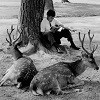A pioneer in the ethical traceability of products of animal origin: Marguerite Yourcenar
DOI:
https://doi.org/10.51777/relief12347Keywords:
Traceability, ethics, Marguerite Yourcenar, animal, Anti-speciesism, ecocriticismAbstract
Convinced that the unity of humanity is that of a biological species that we cannot extract from all the forms of non-human life which constitute much more than its "environment", Marguerite Yourcenar tries in her work to restore the lost porosity between the human world and the so-called animal species. In this process, she creates a kind of “ethical tracing” going back from the finished animal product to its living origin, which opposes the almost exclusively utilitarian and anthropocentric motives of the commercial traceability.
Downloads

Downloads
Published
Issue
Section
License
Copyright (c) 2022 May Chehab

This work is licensed under a Creative Commons Attribution 4.0 International License.
All articles published in RELIEF appear in Open Access under the Creative Commons Attribution 4.0 International License (CC-BY 4.0). Under this licence, authors retain ownership of the copyright of their article, but they allow its unrestricted use, provided it is properly cited.






